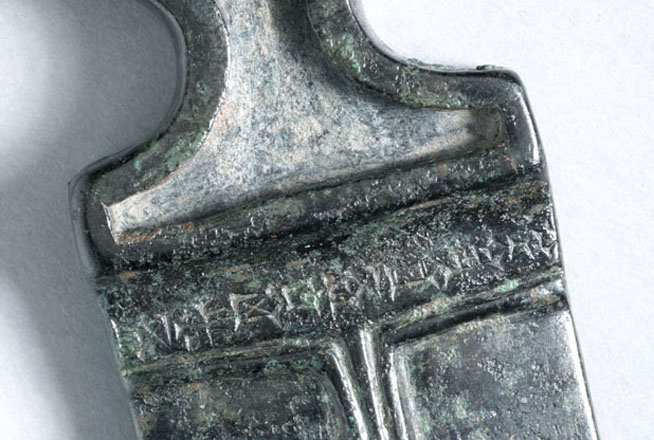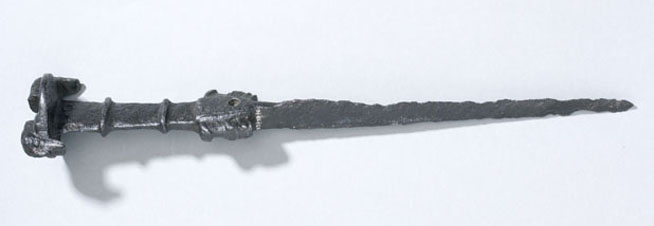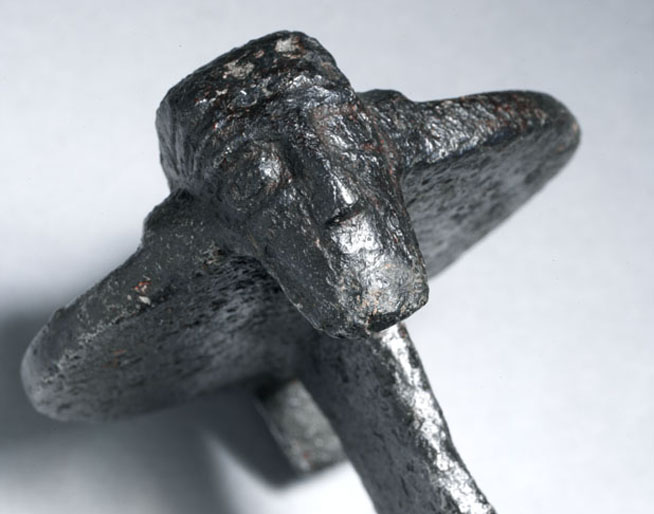Weapon Wednesday: Two daggers from Luristan, Iran

In museum circles the region of Luristan in the Zagros Mountains has a long association with the antiquities looted from tombs there in the 1920's and 30's. These objects seem to be primarily from the Early Iron Age (circa 1000 BC - 750 BC), and comprise an array of distinctive objects that include horse bridles and other equipment; fittings possibly associated with chariots; and an array of weapons, primarily of bronze. These "Luristan bronzes" flooded the market for a while, and some archaeologists also excavated in the region to give the finds some context. However, most of the material associated with Luristan is based on the attribution of dealers. This includes two interesting weapons in the ROM collection.

Detail of inscription on ROM #938.35, the dagger of Marduk-shapik-zeri (ROM Photography)
The first of these is a bronze short sword or dagger (ROM #938.35) which bears a cuneiform inscription in Akkadian saying that it belongs to Marduk-shapik-zeri, "King of the World." Marduk-shapik-zeri (which means "Marduk the outpourer of seed", Marduk being the great god of Babylon). Marduk-shapik-zeri was king of Babylon from about 1082 to 1069 BC, so the weapon will have the same date. The association with Luristan is therefore entirely due to the dealer's attribution, it being acquired from the noted dealer Dikran G. Kelekian in 1938. Conceivably the weapon was taken to Luristan as a diplomatic gift or as booty in subsequent centuries.

Iron dagger ROM# 931.19.10, 40.3 cm long (ROM Photography)
The second object seems more reliably associated with Iran, although it is actually made of iron, not bronze. The iron dagger (ROM# 931.19.10) was purchased from Sotheby's in 1931, and apparently ninety of this style are known, although none are from a specific site. The ROM's object provides a major contribution to our knowledge of these daggers, however, as it has been radio-carbon dated using accelerator mass-spectrometry to 1044 plus or minus 60 years BC (since the date is of the carbon in the object derived from the wood used to smelt the object, the date of the object would probably be 15 years later). Like most iron in this period, it is generally low carbon, but it is very heterogenous with higher carbon areas, essentially being "steel", the alloy of iron and carbon.

Detail of iron dagger ROM# 931.19.10 (ROM Photography), showing bearded heads which were made separately and then forged onto the main piece. These daggers are thought to be high-status items, the pinnacle of the metal workers craft at the time.
So here we have two objects made in the same general area, at about the same time, for what seems to be the same purpose. So why is one made of iron or steel and the other is bronze? It is a common misconception that iron or steel is functionally superior to bronze. The quality of the iron or steel is an important consideration and these early irons are not of the quality of later steel anyway, but even so tests of bronze against iron weapons have shown that the iron is not actually superior to a well-made bronze weapon. The advantage of iron over bronze is the economy of the material itself. Bronze is made of copper and tin, two relatively rare materials - especially tin, which may even have been imported from Britain in this period. Iron is a relatively common material, and once the process of smelting it had been developed, it was possible to supply much more metal for use in weapons and tools. Hence bronze weapons would have continued to be produced as long as people could afford them!
A further interesting aspect of these weapons is how they were used. Daggers are held in a number of specific ways which dictate to a certain degree how you fight with them. The dagger of Marduk-shapik-zeri has a distinct grip that looks odd at first, but when you hold it your hand naturally takes on the "fencer's" grip, with the forefinger and thumb settled into the embayments in the grip. The iron dagger is quiet unwieldy in this grip, as has been mentioned by other authors, but in fact it works very well in the "ice-pick" grip, which I would associate with fighting against heavily armoured opponents.
